Zinc Oxide and Copper Chitosan Composite Films with Antimicrobial Activity
Abstract
1. Introduction
2. Materials and Methods
2.1. Materials
2.2. Preparation of Chitosan Films
2.2.1. Preparation of Unfilled Chitosan Films
2.2.2. Preparation of Glutaraldehyde Crosslinked Chitosan Films
2.2.3. Preparation of Composite Chitosan Films
2.3. Composition and Structural Characterization of CHT Composite Films
2.3.1. Fourier Transform Infrared Spectroscopy (FTIR)
2.3.2. Raman Spectroscopy
2.3.3. Thermogravimetric Analysis (TGA)
2.3.4. X-ray Diffraction (XRD)
2.4. Surface Properties of CHT Composite Films
2.4.1. Scanning Electron Microscopy (SEM)
2.4.2. X-ray Photoelectron Spectroscopy (XPS)
2.4.3. Contact Angles
2.5. Biological Studies
Antimicrobial Activity Assays
3. Results and Discussion
3.1. Physicochemical and Structural Characterization of Modified Chitosan Films
3.1.1. FTIR Spectroscopy
3.1.2. Raman Spectroscopy
3.1.3. Thermogravimetric Analysis (TGA)
3.1.4. X-ray Diffraction (XRD)
3.2. Surface Properties of Modified Chitosan Films
3.2.1. Elemental Composition by EDX and XPS
3.2.2. Surface Morphology by SEM
3.2.3. Contact Angle Measurement
3.3. Antimicrobial Activity
4. Conclusions
Supplementary Materials
Author Contributions
Funding
Institutional Review Board Statement
Informed Consent Statement
Data Availability Statement
Acknowledgments
Conflicts of Interest
References
- Gergova, R.; Georgieva, T.; Angelov, I.; Mantareva, V.; Valkanov, S.; Mitov, I. Photodynamic therapy with water-soluble phtalocyanines against bacterial biofilms in teeth root canals. SPIE 2012, 8427, 842744. [Google Scholar]
- Petti, S.; Boss, M.; Messano, G.; Protano, C.; Polimeni, A. High salivary Staphylococcus aureus carriage rate among healthy paedodontic patients. New Microbiol. 2014, 37, 91–96. [Google Scholar]
- Ohara-Nemoto, Y.; Haraga, H.; Kimura, S.; Nemoto, T.K. Occurrence of staphylococci in the oral cavities of healthy adults and nasal—Oral trafficking of the bacteria. J. Med. Microbiol. 2008, 57, 95–99. [Google Scholar] [CrossRef] [PubMed]
- Smith, A.; Buchinsky, F.J.; Post, J.C. Eradicating chronic ear, nose, and throat infections: A systematically conducted literature review of advances in biofilm treatment. Otolaryngol. Head Neck Surg. 2011, 144, 338–347. [Google Scholar]
- Palareti, G.; Legnani, C.; Cosmi, B.; Antonucci, E.; Erba, N.; Poli, D.; Testa, S.; Tosetto, A. Comparison between different D-Dimer cutoff values to assess the individual risk of recurrent venous thromboembolism: Analysis of results obtained in the DULCIS study. Int. J. Lab. Hematol. 2016, 38, 42–49. [Google Scholar]
- Venkatesan, J.; Kim, S.K. Chitosan composites for bone tissue engineering—An overview. Mar. Drugs 2010, 8, 2252–2266. [Google Scholar] [PubMed]
- Muzzarelli, R. Chitin, 1st ed.; Editorial Pergamon: New York, NY, USA, 1974. [Google Scholar]
- Chuc-Gamboa, M.G.; Vargas-Coronado, R.F.; Cervantes-Uc, J.M.; Cauich-Rodríguez, J.V.; Escobar-García, D.M.; Pozos-Guillén, A.; del Barrio, J.S.R. The Effect of PEGDE Concentration and Temperature on Physicochemical and Biological Properties of Chitosan. Polymers 2019, 11, 1830. [Google Scholar]
- Ardila, N.; Daigle, F.; Heuzey, M.; Abdellah, A. Antibacterial Activity of Neat Chitosan Powder. Molecules 2017, 22, 100. [Google Scholar] [CrossRef]
- Muxika, A.; Etxabide, A.; Uranga, J.; Guerrero, P.; de la Caba, K. Chitosan as a bioactive polymer: Processing, properties and applications. Int. J. Biol. Macromol. 2017, 105, 1358–1368. [Google Scholar] [CrossRef]
- Husain, S.; Al-Samadani, K.H.; Najeeb, S.; Zafar, M.S.; Khurshid, Z.; Zohaib, S.; Qasim, S.B. Chitosan biomaterials for current and potential dental applications. Materials 2017, 10, 602. [Google Scholar] [CrossRef]
- Ayala-Valencia, G. Efecto antimicrobiano del quitosano: Una revisión de la literatura. Scentia Agroaliment. 2015, 2, 32–38. [Google Scholar]
- Agnihotri, S.; Mallikarjuna, N.; Aminabhav, T. Recent advances on chitosan-based micro- and nanoparticles in drug delivery. J. Control. Release 2004, 100, 5–28. [Google Scholar] [PubMed]
- Yu, Q.; Song, Y.; Shi, X.; Xu, C.; Bin, Y. Preparation and properties of chitosan derivative / poly (vinyl alcohol) blend film crosslinked with glutaraldehyde. Carbohydr. Polym. 2011, 84, 465–470. [Google Scholar] [CrossRef]
- Baroudi, A.; García-Payo, C.; Khayet, M. Structural, Mechanical, and Transport Properties of Different Doses. Polymers 2018, 10, 117. [Google Scholar]
- Yao, K.X.; Zeng, H.C. ZnO/PVP Nanocomposite Spheres with Two Hemispheres. J. Phys. Chem. 2007, 111, 13301–13308. [Google Scholar]
- Tabesh, E.; Salimijazi, H.R.; Kharaziha, M.; Mahmoudi, M.; Hejazi, M. Development of an In-Situ Chitosan-Copper Nanoparticle Coating by Electrophoretic Deposition. Surf. Coat. Technol. 2019, 364, 239–247. [Google Scholar]
- Hardy, J.J.E.; Hubert, S.; Macquarrie, D.J.; Wilson, A.J. Chitosan-based heterogeneous catalysts for suzuki and heck reactions. Green Chem. 2004, 6, 53–56. [Google Scholar]
- Aguilar-Pérez, D.; Vargas-Coronado, R.; Cervantes-Uc, J.; Rodriguez-Fuentes, N.; Aparicio, C.; Covarrubias, C.; Alvarez-Perez, M.; Garcia-Perez, V.; Martinez-Hernandez, M.; Cauich-Rodriguez, J. Antibacterial activity of a glass ionomer cement doped with copper nanoparticles. Dent. Mater. J. 2020, 39, 389–396. [Google Scholar] [CrossRef]
- Bolaina-Lorenzo, E.; Martinez-Ramos, C.; Monleón-Pradas, M.; Herrera-Kao, W.; Cauich-Rodriguez, J.V.; Cervantes-Uc, J.M. Electrospun polycaprolactone/chitosan scaffolds for nerve tissue engineering: Physicochemical characterization and Schwann cell biocompatibility. Biomed. Mater. 2017, 12, 15008. [Google Scholar] [CrossRef]
- Ki-jae, J.; Younseong, S.; Hye-ri, S.; Ji, E.; Jeonghyo, K.; Fangfang, S.; Dae-Youn, H.; Jaebeom, L. In vivo study on the biocompatibility of chitosan-hydroxyapatite film depending on degree of deacetylation. J. Biomed. Mater. Res. A 2017, 105, 1637–1645. [Google Scholar]
- Bandara, S.; Carnegie, C.-a.; Johnson, C.; Akindoju, F.; Williams, E.; Swaby, J.M.; Oki, A.; Carson, L.E. Synthesis and characterization of Zinc/Chitosan-Folic acid complex. Heliyon 2018, 4, e00737. [Google Scholar] [CrossRef]
- Bujñáková, Z.; Dutková, E.; Zorkovská, A.; Baláz, M.; Kovác, J.; Kello, M.; Mojzis, J.; Briancin, J.; Baláz, P. Mechanochemical synthesis and in vitro studies pf chitosan-coated InAs/ZnS mixed nanocrystals. J. Mater. Sci. 2017, 52, 721–735. [Google Scholar] [CrossRef]
- Muraleedharan, K.; Alikutty, P.; Abdul Mujeeb, V.M.; Sarada, K. Kinetic Studies on the Thermal Dehydration and Degradation of Chitosan and Citralidene Chitosan. J. Polym. Environ. 2015, 23, 1–10. [Google Scholar]
- Li, B.; Shan, C.-L.; Zhou, Q.; Fang, Y.; Wang, Y.-L.; Xu, F.; Sun, G.-C. Synthesis, Characterization, and Antibacterial Activity of Cross-Linked Chitosan-Glutaraldehyde. Mar. Drugs 2013, 11, 1534–1552. [Google Scholar] [CrossRef] [PubMed]
- Chen, J.H.; Dong, X.F.; He, Y.S. Investigation into glutaraldehyde crosslinked chitosan/cardo-poly-etherketone composite membrane for pervaporation separation of methanol and dimethyl carbonate mixtures. RSC Adv. 2016, 6, 60765–60772. [Google Scholar]
- Djaja, N.F.; Montja, D.A.; Saleh, R. The Effect of Co Incorporation into ZnO Nanoparticles. Adv. Mater. Phys. Chem. 2013, 3, 33–41. [Google Scholar]
- Hernández, A.; Maya, L.; Sánchez-Mora, E.; Sánchez, E.M. Sol-gel synthesis, characterization and photocatalytic activity of mixed oxide ZnO-Fe2O3. J. Sol-Gel Sci. Technol. 2007, 42, 71–78. [Google Scholar] [CrossRef]
- Dobrucka, R.; Długaszewska, J. Biosynthesis and antibacterial activity of ZnO nanoparticles using Trifolium pratense flower extract. Saudi J. Biol. Sci. 2016, 23, 517–523. [Google Scholar]
- Miri, A.; Mahdinejad, N.; Ebrahimy, O.; Khatami, M.; Sarani, M. Zinc oxide nanoparticles: Biosynthesis, characterization, antifungal and cytotoxic activity. Mater. Sci. Eng. C 2019, 104, 109981. [Google Scholar]
- Youssef, A.M.; Abou-Yousef, H.; El-Sayed, S.M.; Kamel, S. Mechanical and antibacterial properties of novel high performance chitosan/nanocomposite films. Int. J. Biol. Macromol. 2015, 76, 25–32. [Google Scholar] [CrossRef]
- Facchin, G.; Alvarez, N.; Sapiro, R.; Péres-Araujo, M. Desarrollo de complejos de cobre con actividad antitumoral: Síntesis y caracterización de un nuevo complejo de cobre-terpiridina. Inf. Tecnol. 2012, 23, 25–30. [Google Scholar] [CrossRef][Green Version]
- Ceja-Romero, L.R.; Ortega-Arroyo, L.; Ortega Rueda De León, J.M.; López-Andrade, X.; Narayanan, J.; Aguilar-Méndez, M.A.; Castaño, V.M. Green chemistry synthesis of nano-cuprous oxide. IET Nanobiotech. 2016, 10, 39–44. [Google Scholar] [CrossRef]
- Maldonado-Lara, K.; Luna-Bárcenas, G.; Luna-Hernández, E.; Padilla-Vaca, F.; Hernández-Sánchez, E.; Betancourt-Galindo, R.; Menchaca-Arredondo, J.L.; España-Sánchez, B.L. Preparación y caracterización de nanocompositos quitosano-cobre con actividad antibacteriana para aplicaciones en ingeniería de tejidos. Rev. Mex. Ing. Biomed. 2017, 38, 306–313. [Google Scholar]
- Gritsch, L.; Lovell, C.; Goldmann, W.H.; Boccaccini, A.R. Fabrication and characterization of copper(II)-chitosan complexes as antibiotic-free antibacterial biomaterial. Carbohydr. Polym. 2018, 179, 370–378. [Google Scholar] [CrossRef] [PubMed]
- Brugnerotto, J.; Lizardi, J.; Goycoolea, F.M.; Argüelles-Monal, W.; Desbrières, J.; Rinaudo, M. An infrared investigation in relation with chitin and chitosan characterization. Polymer 2001, 42, 3569–3580. [Google Scholar]
- Li, W.; Xiao, L.; Qin, C. The characterization and thermal investigation of chitosan-Fe3O4 nanoparticles synthesized via a novel one-step modifying process. J. Macromol. Sci. Part. A Pure Appl. Chem. 2011, 48, 57–64. [Google Scholar]
- Samuels, R.J. Solid State Characterization of the Structure of Chitosan Films. J. Polym. Sci. Part. A-2 Polym. Phys. 1981, 19, 1081–1105. [Google Scholar] [CrossRef]
- Vartiainen, J.; Harlin, A. Crosslinking as an Efficient Tool for Decreasing Moisture Sensitivity of Biobased Nanocomposite Films. Mater. Sci. Appl. 2011, 2, 346–354. [Google Scholar] [CrossRef]
- Beyene, Z.; Ghosh, R. Effect of zinc oxide addition on antimicrobial and antibio film activity of hydroxyapatite: A potential nanocomposite for biomedical applications. Mater. Today Commun. 2019, 21, 100612. [Google Scholar] [CrossRef]
- Ai, L.; He, H.; Wang, P.; Cai, R.; Tao, G.; Yang, M.; Liu, L.; Zuo, H.; Zhao, P.; Wang, Y. Rational design and fabrication of ZnONPs functionalized sericin/PVA antimicrobial sponge. Int. J. Mol. Sci. 2019, 20, 4796. [Google Scholar] [CrossRef]
- Gutiérrez, M.F.; Bermudez, J.; Dávila-Sánchez, A.; Alegría-Acevedo, L.F.; Méndez-Bauer, L.; Hernández, M.; Astorga, J.; Reis, A.; Loguercio, A.D.; Farago, P.V.; et al. Zinc oxide and copper nanoparticles addition in universal adhesive systems improve interface stability on caries-affected dentin. J. Mech. Behav. Biomed. Mater. 2019, 100, 103366. [Google Scholar] [CrossRef] [PubMed]
- Oyrton, A.C.; Monteiro, J.; Claudio, A. Some studies of crosslinking chitosan-glutaraldehyde interaction in a homogeneous system. Int. J. Biol. Macromol 1999, 26, 119–128. [Google Scholar]
- Drelich, J.; Chibowski, E.; Meng, D.D.; Terpilowski, K. Hydrophilic and superhydrophilic surfaces and materials. Soft Matter. 2011, 7, 9804–9828. [Google Scholar]
- Kang, B.; Vales, T.P.; Cho, B.K.; Kim, J.K.; Kim, H.J. Development of gallic acid-modified hydrogels using interpenetrating chitosan network and evaluation of their antioxidant activity. Molecules 2017, 22, 1976. [Google Scholar] [CrossRef] [PubMed]
- Beppu, M.M.; Vieira, R.S.; Aimoli, C.G.; Santana, C.C. Crosslinking of chitosan membranes using glutaraldehyde: Effect on ion permeability and water absorption. J. Memb. Sci. 2007, 301, 126–130. [Google Scholar] [CrossRef]
- Grundke, K.; Pöschel, K.; Synytska, A.; Frenzel, R.; Drechsler, A.; Nitschke, M.; Cordeiro, A.L.; Uhlmann, P.; Welzel, P.B. Experimental studies of contact angle hysteresis phenomena on polymer surfaces—Toward the understanding and control of wettability for different applications. Adv. Colloid Interface Sci. 2015, 222, 350–376. [Google Scholar] [CrossRef]
- Imani, Z.; Imani, Z.; Basir, L.; Mohsen, S.; Montazeri, E.A.; Vahid, R. Antibacterial Effects of Chitosan, Formocresol and CMCP as Pulpectomy Medicament on Enterococcus faecalis, Staphylococcus aureus and Streptococcus mutans. Iran. Endod. J. 2018, 13, 342–350. [Google Scholar] [PubMed]
- Hu, Z.Y.; Balay, D.; Hu, Y.; McMullen, L.M.; Gänzle, M.G. Effect of chitosan, and bacteriocin—Producing Carnobacterium maltaromaticum on survival of Escherichia coli and Salmonella typhimurium on beef. Int. J. Food Microbiol. 2019, 290, 68–75. [Google Scholar] [PubMed]
- Erickson, M.C.; Liao, J.Y.; Payton, A.S.; Cook, P.W.; Adhikari, K.; Wang, S.; Bautista, J.; Pérez, J.C.D. Efficacy of acetic acid or chitosan for reducing the prevalence of Salmonella- and Escherichia coli O157: H7-contaminated leafy green plants in field systems. J. Food Prot. 2019, 82, 854–861. [Google Scholar] [CrossRef]
- Mohamed, N.A.; Fahmy, M.M. Synthesis and antimicrobial activity of some novel cross-linked chitosan hydrogels. Int. J. Mol. Sci. 2012, 13, 11194–11209. [Google Scholar] [CrossRef]
- Chuc-Gamboa, M.G.; Perera, C.M.C.; Ayala, F.J.A.; Vargas-Coronado, R.F.; Cauich-Rodríguez, J.V.; Escobar-García, D.M.; Sánchez-Vargas, L.O.; Pacheco, N.; Del Barrio, J.S.R. Antibacterial behavior of chitosan-sodium hyaluronate-PEGDE crosslinked films. Appl. Sci. 2021, 11, 1267. [Google Scholar]
- Sehmi, S.K.; Allan, E.; MacRobert, A.J.; Parkin, I. The bactericidal activity of glutaraldehyde-impregnated polyurethane. Microbiology 2016, 5, 891–897. [Google Scholar] [CrossRef] [PubMed]
- Cheknev, S.B.; Vostrova, E.I.; Piskovskaia, L.S.; Vostrov, A.V. Effects of copper and zinc cations bound by gamma-globulin fraction in Staphylococcus aureus culture. Zh. Mikrobiol. Epidemiol. Immunobiol. 2014, 3, 4–9. [Google Scholar]
- Bharathi, D.; Ranjithkumar, R.; Chandarshekar, B.; Bhuvaneshwari, V. Preparation of chitosan coated zinc oxide nanocomposite for enhanced antibacterial and photocatalytic activity: As a bionanocomposite. Int. J. Biol. Macromol. 2019, 129, 989–996. [Google Scholar] [CrossRef]
- Brahma, U.; Kothari, R.; Sharma, P.; Bhandari, V. Antimicrobial and anti-biofilm activity of hexadentated macrocyclic complex of copper (II) derived from thiosemicarbazide against Staphylococcus aureus. Sci. Rep. 2018, 8, 1–8. [Google Scholar] [CrossRef] [PubMed]
- Li, K.; Xia, C.; Qiao, Y.; Liu, X. Dose-response relationships between copper and its biocompatibility/antibacterial activities. J. Trace Elem. Med. Biol. 2019, 55, 127–135. [Google Scholar] [PubMed]
- Isobe, K. The strategy for existence of microorganisms-adhesion to solid surfaces. J. Surf. Sci Soc. 2001, 22, 652–662. [Google Scholar] [CrossRef]
- Du, W.L.; Niu, S.S.; Xu, Y.L.; Xu, Z.R.; Fan, C.L. Antibacterial activity of chitosan tripolyphosphate nanoparticles loaded with various metal ions. Carbohydr. Polym. 2009, 75, 385–389. [Google Scholar] [CrossRef]
- Chung, Y.C.; Su, Y.P.; Chen, C.C.; Jia, G.; Wang, H.I.; Wu, J.C.; Lin, J.G. Relationship between antibacterial activity of chitosan and surface characteristics of cell wall. Acta Pharmacol Sin. 2004, 25, 932–936. [Google Scholar]
- Yasuyuki, M.; Kunihiro, K.; Kurissery, S.; Kanavillil, N.; Sato, Y.; Kikuchi, Y. Antibacterial properties of nine pure metals: A laboratory study using Staphylococcus aureus and Escherichia coli. Biofouling J. Bioadhesion Biofilm 2010, 26, 37–41. [Google Scholar] [CrossRef]
- Azam, A.; Ahmed, A.S.; Oves, M.; Khan, M.S.; Habib, S.S.; Memic, A. Antimicrobial activity of metal oxide nanoparticles against Gram-positive and Gram-negative bacteria: A comparative study. Int. J. Nanomed. 2012, 7, 6003–6009. [Google Scholar] [CrossRef] [PubMed]
- Achard, M.E.S.; Stafford, S.L.; Bokil, N.J.; Chartres, J.; Bernhardt, P.V.; Schembri, M.A.; Sweet, M.J.; Mcewan, A.G. Copper redistribution in murine macrophages in response to Salmonella infection. Biochem. J. 2012, 444, 51–57. [Google Scholar] [CrossRef]
- Beal, J.D.; Niven, S.J.; Campbell, A.; Brooks, P.H. The effect of copper on the death rate of Salmonella typhimurium DT104:30 in food substrates acidified with organic acids. Lett. Appl. Microbiol. 2004, 38, 8–12. [Google Scholar] [CrossRef] [PubMed]
- Karbowniczek, J.; Cordero-Arias, L.; Virtanen, S.; Misra, S.K.; Valsami-Jones, E.; Tuchscherr, L.; Rutkowski, B.; Górecki, K.; Bała, P.; Czyrska-Filemonowicz, A.; et al. Electrophoretic deposition of organic/inorganic composite coatings containing ZnO nanoparticles exhibiting antibacterial properties. Mater. Sci. Eng. C 2017, 77, 780–789. [Google Scholar] [CrossRef] [PubMed]
- Fernández-Arias, M.; Boutinguiza, M.; del Val, J.; Covarrubias, C.; Bastias, F.; Gómez, L.; Maureira, M.; Arias-González, F.; Riveiro, A.; Pou, J. Copper nanoparticles obtained by laser ablation in liquids as bactericidal agent for dental applications. Appl. Surf. Sci. 2019, 507, 145032. [Google Scholar] [CrossRef]
- Liu, R.; Ma, Z.; Kunle, S.; Lilan, K.; Ying, Z.; Ling, Z.; Ke, R. In Vitro study on cytocompatibility and osteogenesis ability of Ti-Cu alloy. J. Mater. Sci. Mater. Med. 2019, 34, 1112–1126. [Google Scholar]
- Yue, R.; Niu, J.; Li, Y.; Ke, G.; Huang, H.; Pei, J.; Ding, W. Materials Science & Engineering C In vitro cytocompatibility, hemocompatibility and antibacterial properties of biodegradable Zn-Cu-Fe alloys for cardiovascular stents applications. Mater. Sci. Eng. C 2020, 113, 111007. [Google Scholar]
- Zhu, D.; Su, Y.; Young, M.L.; Zheng, Y.; Tang, L. Biological Responses and Mechanisms of Human Bone Marrow Mesenchymal Stem Cells to Zn and Mg Biomaterials. ACS Appl. Mater. Interfaces 2017, 9, 27453–27461. [Google Scholar] [CrossRef]
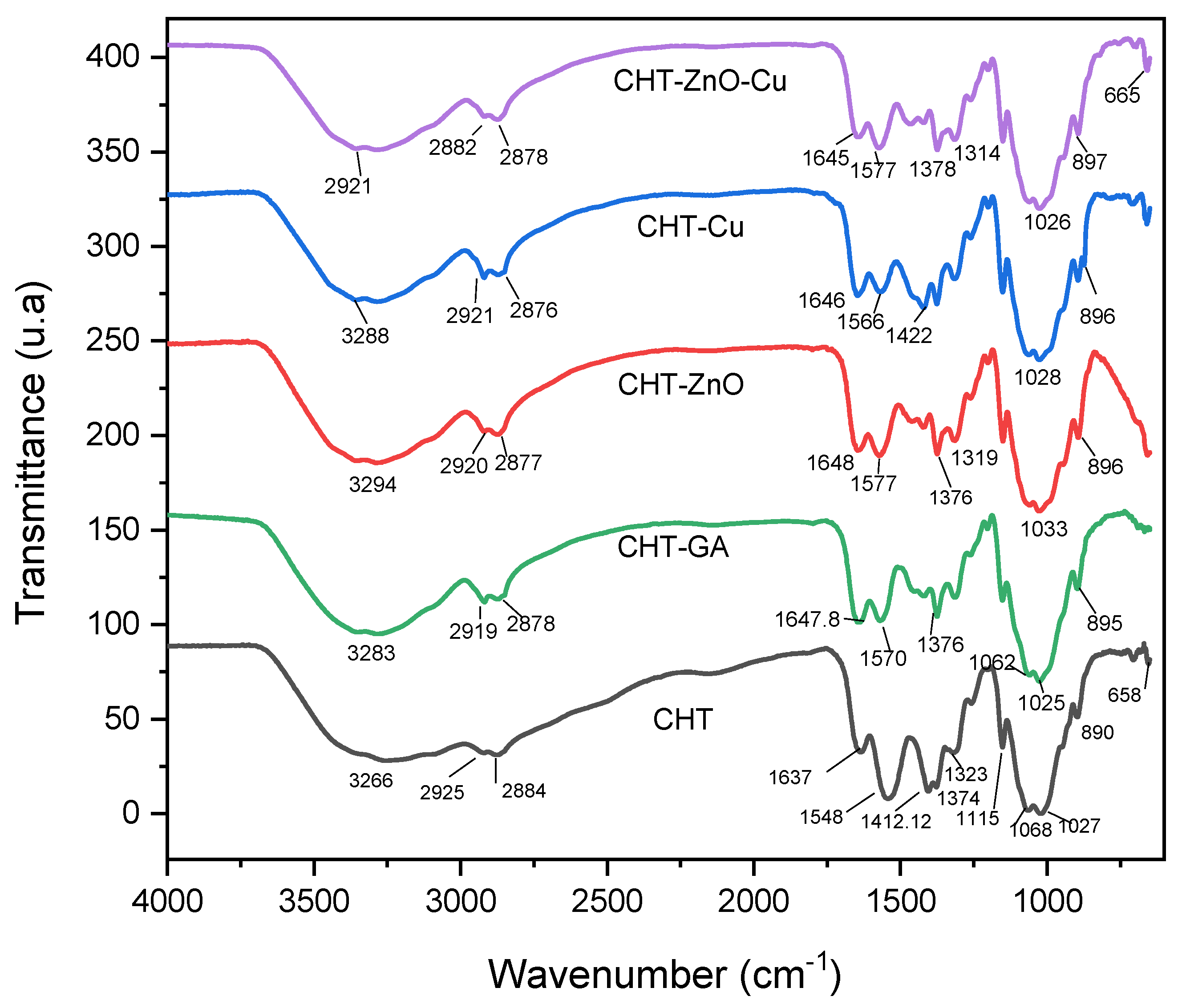
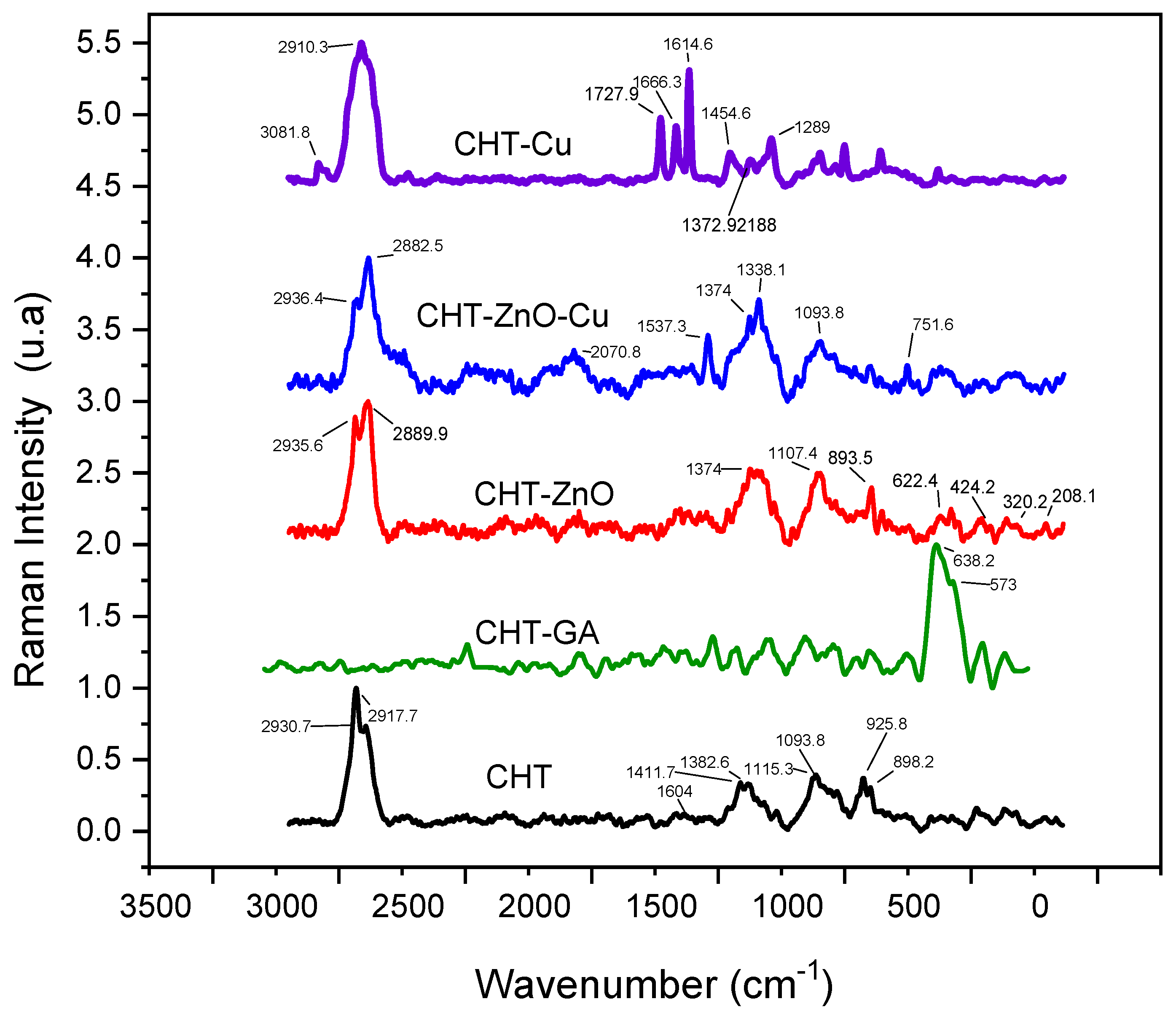
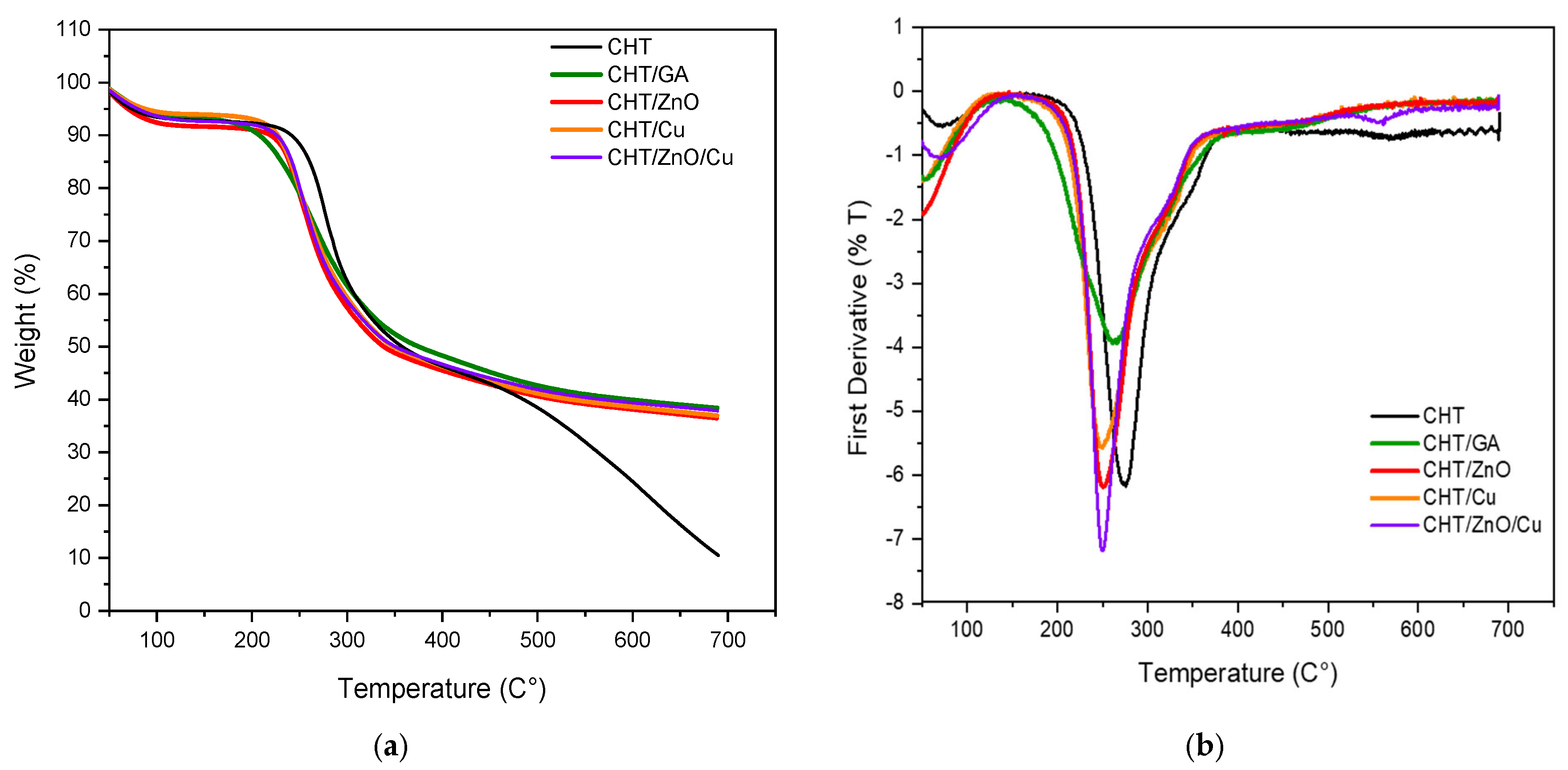
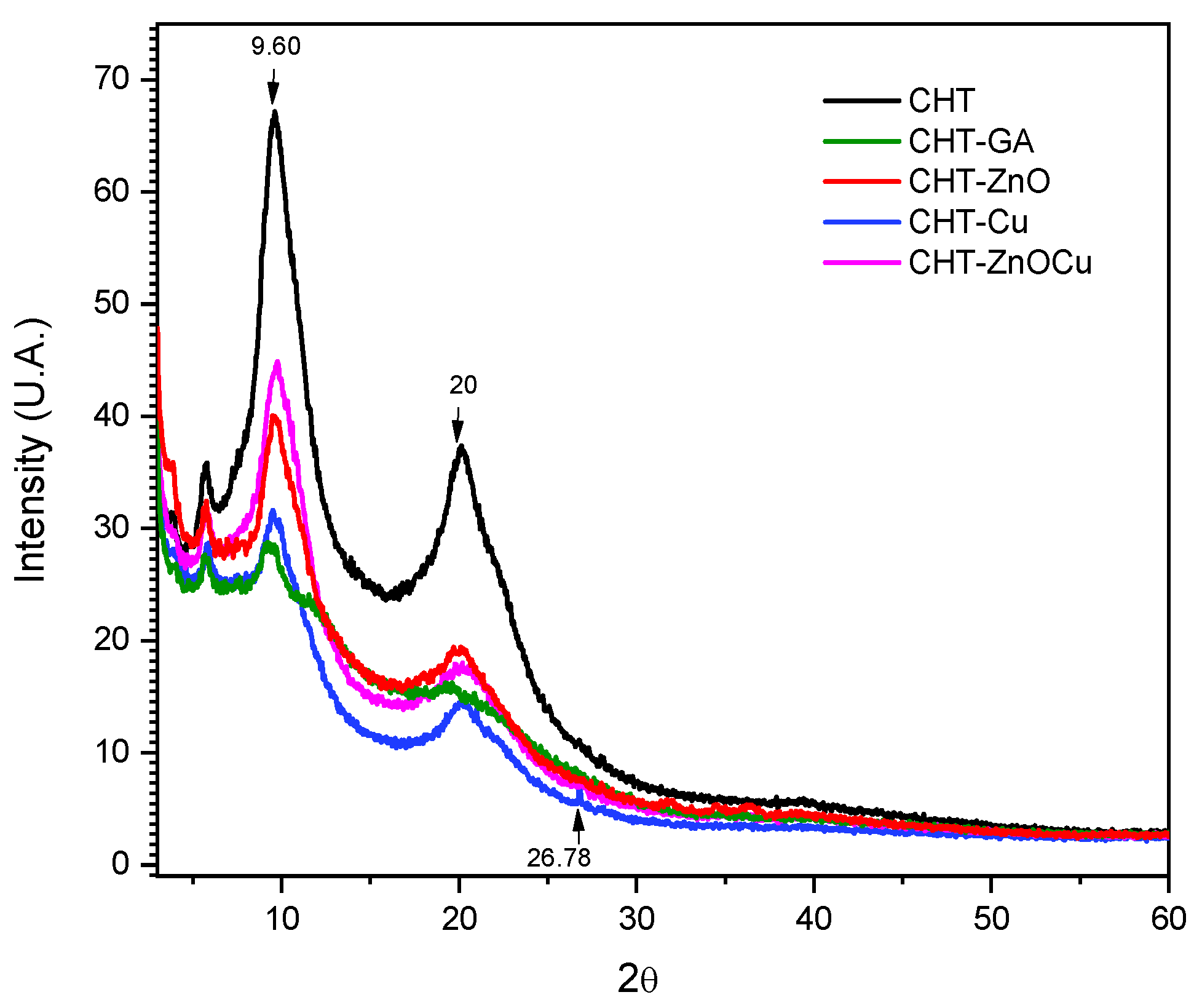

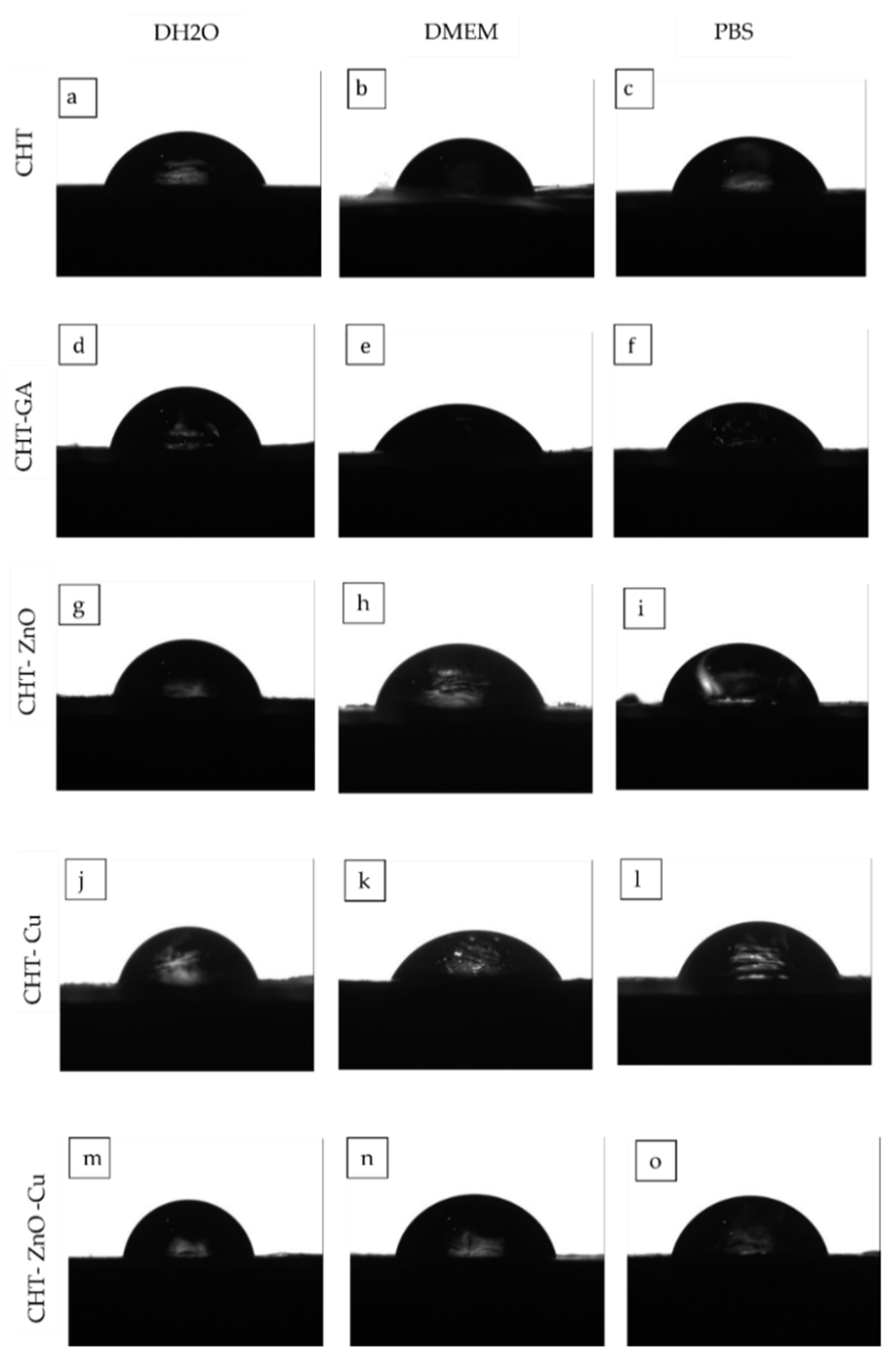
| CHT | CHT + GA | CHT + ZnO | CHT + Cu | CHT+ ZnO + Cu | |
|---|---|---|---|---|---|
| Chitosan | 200 mg | 200 mg | 190 mg | 198 mg | 188 mg |
| Glutaraldehyde | 150 µL | ||||
| ZnO 5 wt.% | 10 mg | 10 mg | |||
| Copper 1 wt.% | 2 mg | 2 mg |
| Films | Td (°C) | T (°C) at 50% of Weight Loss | Residual Mass (%) |
|---|---|---|---|
| CHT | 276 | 358 | 10.45 |
| CHT/GA | 262 | 375 | 38.38 |
| CHT/Zn-O | 251 | 338 | 36.47 |
| CHT/Cu | 247 | 348 | 36.96 |
| CHT/Zn-O/Cu | 249 | 350 | 37.89 |
| CHT | CHT/GA | CHT/ZnO | CHT/Cu | CHT/ZnO/Cu | ||||||
|---|---|---|---|---|---|---|---|---|---|---|
| % | XPS | EDX | XPS | EDX | XPS | EDX | XPS | EDX | XPS | EDX |
| C | 88.59 | 52.64 | 77.52 | 62 | 87.28 | 64.69 | 85.6 | 58.62 | 87.93 | 55.13 |
| O | 11.41 | 41.73 | 18.63 | 38 | 11.09 | 33.54 | 12.63 | 38.82 | 11.4 | 41.73 |
| N | 5.63 | 3.85 | 1.63 | 1.72 | 1.77 | 2.5 | 3.12 | |||
| Zn | 0.05 | 0.66 | ||||||||
| Cu | 0.07 | 0.02 | ||||||||
| Film | H2O (°) | DMEM (°) | PBS (°) |
|---|---|---|---|
| CHT | 88.29 ± 0.33 | 88.60 ± 0.54 | 88.41 ± 0.33 |
| CHT-GA | 88.75 ± 0.22 | 87.35 ± 0.56 | 87.31 ± 1.14 |
| CHT-ZnO | 89.0 ± 0.39 | 103.33 ± 22.72 | 89.00 ± 0.53 |
| CHT-Cu | 88.40 ± 0.58 | 87.16 ± 0.49 | 87.98 ± 0.83 |
| CHT-ZnO-Cu | 89.51 ± 0.41 | 88.41 ± 0.69 | 89.01 ± 0.35 |
| Film | Antibacterial Activity Staphylococcus Aureus | Antibacterial Activity Salmonella Typhimurium |
|---|---|---|
| CHT | (−)  | (+)  |
| CHT + GA | (+)  | (+)  |
| CHT + Zn-O | (−)  | (+)  |
| CHT + Cu | (−)  | (+)  |
| CHT+ ZnOCu | (−) | (+)  |
Publisher’s Note: MDPI stays neutral with regard to jurisdictional claims in published maps and institutional affiliations. |
© 2021 by the authors. Licensee MDPI, Basel, Switzerland. This article is an open access article distributed under the terms and conditions of the Creative Commons Attribution (CC BY) license (https://creativecommons.org/licenses/by/4.0/).
Share and Cite
Gamboa-Solana, C.d.C.; Chuc-Gamboa, M.G.; Aguilar-Pérez, F.J.; Cauich-Rodríguez, J.V.; Vargas-Coronado, R.F.; Aguilar-Pérez, D.A.; Herrera-Atoche, J.R.; Pacheco, N. Zinc Oxide and Copper Chitosan Composite Films with Antimicrobial Activity. Polymers 2021, 13, 3861. https://doi.org/10.3390/polym13223861
Gamboa-Solana CdC, Chuc-Gamboa MG, Aguilar-Pérez FJ, Cauich-Rodríguez JV, Vargas-Coronado RF, Aguilar-Pérez DA, Herrera-Atoche JR, Pacheco N. Zinc Oxide and Copper Chitosan Composite Films with Antimicrobial Activity. Polymers. 2021; 13(22):3861. https://doi.org/10.3390/polym13223861
Chicago/Turabian StyleGamboa-Solana, Candy del Carmen, Martha Gabriela Chuc-Gamboa, Fernando Javier Aguilar-Pérez, Juan Valerio Cauich-Rodríguez, Rossana Faride Vargas-Coronado, David Alejandro Aguilar-Pérez, José Rubén Herrera-Atoche, and Neith Pacheco. 2021. "Zinc Oxide and Copper Chitosan Composite Films with Antimicrobial Activity" Polymers 13, no. 22: 3861. https://doi.org/10.3390/polym13223861
APA StyleGamboa-Solana, C. d. C., Chuc-Gamboa, M. G., Aguilar-Pérez, F. J., Cauich-Rodríguez, J. V., Vargas-Coronado, R. F., Aguilar-Pérez, D. A., Herrera-Atoche, J. R., & Pacheco, N. (2021). Zinc Oxide and Copper Chitosan Composite Films with Antimicrobial Activity. Polymers, 13(22), 3861. https://doi.org/10.3390/polym13223861









